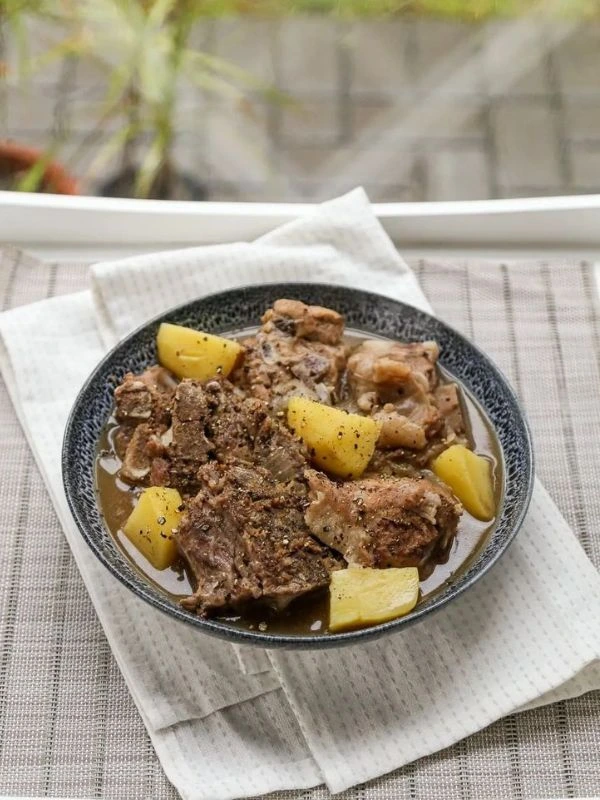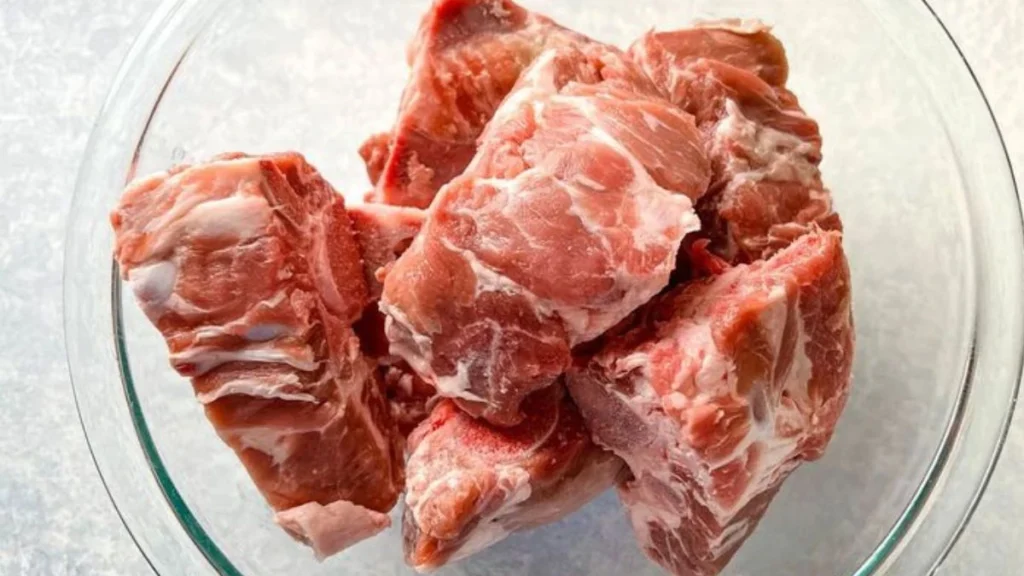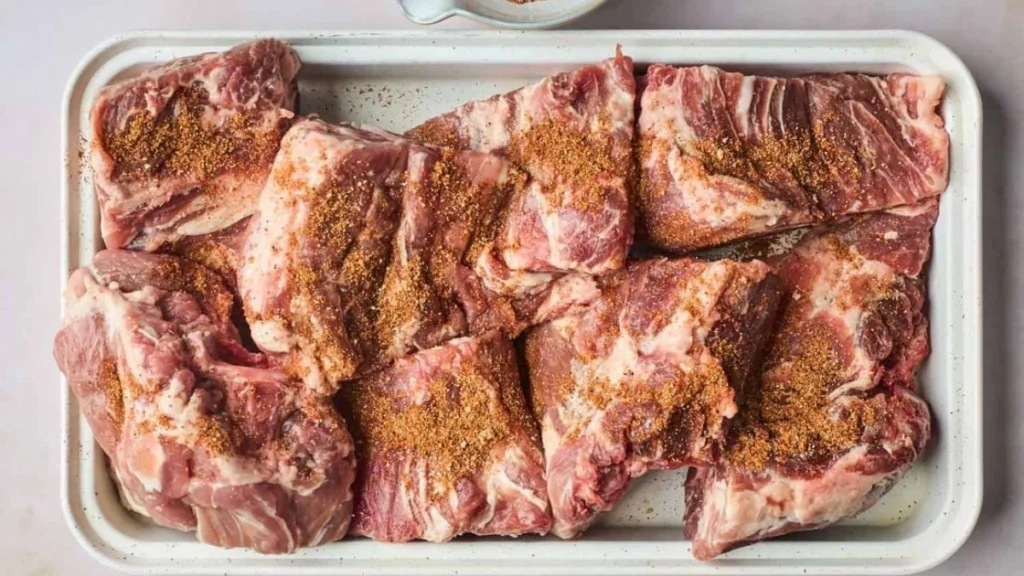Table of Contents
Southern-style comfort meals are hard to beat, especially with savory neck bones. This classic dish adds warmth and rich flavor to your dinner. It turns a simple cut of meat into a masterpiece, offering fall-off-the-bone meat with every bite.
Neck bones are more than a recipe; they’re a treasured tradition in Southern kitchens. These tender, flavorful cuts add incredible depth of taste. They make simple ingredients into a memorable meal. Whether you’re an experienced cook or new to the kitchen, this recipe will help you create a dish that connects you to generations of home cooking.

Key Takeaways
- Learn how to cook authentic Southern neck bones
- Master techniques for tender, flavorful meat
- Discover the cultural significance of this classic dish
- Understand proper seasoning and cooking methods
- Transform an economical cut into a gourmet meal
Understanding the Magic of Neck Bones in Southern Cuisine
Beef neck bones are a treasured part of Southern cuisine. They show the value of being resourceful and creative in cooking. These cuts of meat tell a story of cultural strength and culinary art.
Southern cooking turns simple ingredients into amazing meals. Neck bones are a perfect example of this magic. They show how generations have made the most of every ingredient.
History and Cultural Significance
In tough times, African American and Southern communities found ways to make beef neck bones into tasty dishes. These cuts became signs of survival, community, and creativity in cooking.
- Originated during challenging economic periods
- Represented resourceful cooking techniques
- Became a staple in Southern households
Nutritional Benefits of Neck Bones
Neck bones are full of nutrients that are good for your health. They have lots of protein, minerals, and collagen. They’re not just tasty, but also healthy.
| Nutrient | Amount per Serving | Health Benefit |
|---|---|---|
| Protein | 22g | Muscle building |
| Calcium | 50mg | Bone health |
| Iron | 2.5mg | Blood circulation |
Different Types of Neck Bones Available
There are many types of beef neck bones, each with its own special qualities. Knowing about these differences helps you pick the right one for your Southern dishes.
- Beef neck bones
- Grass-fed neck bones
- Organic neck bones
Essential Ingredients for Perfect Neck-Bones
Starting a delicious neck-bones dish means picking the right ingredients. You’ll learn about the key parts that make this simple meat into a tasty meal.
The base of a great neck-bones recipe is high-quality protein. Choose fresh neck-bones from a reliable butcher. Look for some fat marbling for extra flavor and tenderness.
- Primary Protein: Beef neck-bones
- Fresh, well-trimmed cuts
- Bone-in varieties for maximum flavor
Flavorful seasoning is key to making your neck-bones stand out. A mix of spices will turn your dish into a memorable meal.
- Kosher salt
- Black pepper
- Garlic powder
- Paprika
- Cayenne pepper (optional for heat)
Aromatic vegetables add depth and complexity. They create a rich, flavorful base that goes well with the neck-bones.
- Onions
- Celery
- Bell peppers
- Garlic cloves
“The secret to great neck-bones is in the balance of seasoning and fresh ingredients.” – Southern Cooking Tradition
Your final ingredient mix will make a dish that’s rich and satisfying. It celebrates traditional Southern cooking.

Kitchen Tools and Equipment You’ll Need
Preparing delicious neck-bones needs the right tools and kitchen equipment. Whether you’re a seasoned chef or a home cook, the right gear makes cooking smoother and more fun.
Basic Cooking Equipment
To start with your neck-bones recipe, you’ll need some basic kitchen equipment:
- Large Dutch oven or heavy-bottomed pot
- Sharp chef’s knife
- Cutting board
- Meat thermometer
- Wooden spoon or spatula
- Colander for draining
Optional but Helpful Tools
These tools can make your neck-bones preparation better and more efficient:
- Slow cooker for tender meat
- Pressure cooker for faster cooking
- Kitchen tongs
- Meat cleaver
- Kitchen scale for precise measurements
Storage Solutions
Proper storage is key to keeping your cooked neck-bones fresh. Here are some storage containers to consider:
| Container Type | Best For | Storage Duration |
|---|---|---|
| Airtight glass containers | Refrigerator storage | 3-4 days |
| Freezer-safe plastic containers | Long-term freezer storage | Up to 3 months |
| Vacuum-sealed bags | Maximum freshness preservation | Up to 6 months |
Investing in quality kitchen equipment and storage solutions makes preparing and preserving your neck-bones easy and confident.
Preparing and Seasoning Your Neck-Bones
Preparing neck-bones is an art that turns simple meat into a tasty dish. Before cooking, you need to learn a few key steps. These steps will improve the flavor and texture of your neck bones.
First, clean the neck-bones well under cold running water. Take off any extra fat or unwanted tissue that could change the taste. Then, dry the meat with paper towels. This helps the seasoning stick better.
Essential Seasoning Techniques
- Start with a mix of kosher salt and black pepper
- Add garlic powder for more flavor
- Paprika gives a subtle smoky taste
- Cayenne pepper adds a bit of heat
Seasoning is key to enhancing flavor. Make a strong spice mix by combining:
| Seasoning | Quantity | Purpose |
|---|---|---|
| Kosher Salt | 2 tablespoons | Primary flavor base |
| Black Pepper | 1 tablespoon | Adds warmth |
| Garlic Powder | 1 teaspoon | Depth of flavor |
| Dried Thyme | 1/2 teaspoon | Herbal notes |
Pro tip: Let the seasoned neck-bones sit for 30 minutes before cooking. This lets the spices soak into the meat.
“Great cooking is about layering flavors, and neck-bones are the perfect canvas for culinary creativity.” – Southern Cooking Experts
When seasoning, make sure to cover every part of the neck-bones. Rub the spice mix well into all the nooks and crannies. This ensures each bite is packed with flavor.

Step-by-Step Cooking Instructions
Cooking neck-bones needs patience and the right method. This turns a cheap cut into a delicious meal. Slow cooking ensures the meat becomes tender and effortlessly falls off the bone.
Initial Preparation Phase
Before cooking, follow these steps:
- Rinse the neck-bones under cold water
- Use paper towels to pat dry and remove any excess moisture.
- Season generously with salt, pepper, and your favorite spice blend
Cooking Process
The secret to perfect neck-bones is low and slow heat. Choose your cooking method:
| Cooking Method | Estimated Time | Temperature |
|---|---|---|
| Slow Cooker | 6-8 hours | Low (195°F) |
| Oven Braising | 3-4 hours | 325°F |
| Stovetop | 2-3 hours | Low simmer |
Final Touches and Timing
The goal is to make the meat so tender it melts. Check the meat’s doneness by gently pulling with a fork. When it easily pulls away from the bone, it’s done.
“Patience is the most important ingredient when slow-cooking neck-bones.” – Southern Cooking Tradition
Pro tip: Let the meat rest for 10-15 minutes after cooking. This allows juices to redistribute, making it more flavorful and tender.
Serving Suggestions and Side Dishes
Neck-bones are best when paired with the right sides. Southern side dishes make this hearty protein a memorable meal. It’s satisfying from start to finish.
When choosing sides for neck-bones, think of Southern classics. These dishes balance flavors and textures for a complete meal.
Classic Southern Side Dish Recommendations
- Creamy mashed potatoes
- Collard greens with smoked ham hock
- Buttery corn bread
- Black-eyed peas
- Macaroni and cheese
| Side Dish | Flavor Profile | Complementary Rating |
|---|---|---|
| Collard Greens | Earthy, Smoky | ★★★★★ |
| Macaroni and Cheese | Creamy, Rich | ★★★★☆ |
| Cornbread | Sweet, Buttery | ★★★★☆ |
Choosing the right sides can turn neck-bones into a special dish. Feel free to try new flavors that match your taste and cooking style.
Remember, neck bone pairings aim for a balanced plate. Each side should add something special to the meal.
Storage Tips and Reheating Methods
Keeping your neck-bones tasty means storing and reheating them right. This way, you can enjoy your meal over and over again. It keeps the taste and texture just as good as the first time.
Proper Storage Guidelines
Here’s how to store neck-bones to keep them fresh and safe:
- Cool the neck-bones completely before storing
- Use airtight containers to prevent moisture loss
- Refrigerate within two hours of cooking
- Store in the refrigerator for up to 3-4 days
Best Reheating Practices
Reheating leftovers needs care to keep the meat tender and flavorful. Here are some top ways to reheat cooked neck-bones:
- Oven method: Preheat to 350°F, cover with foil to retain moisture
- Stovetop method: Use low heat with a splash of broth
- Microwave: Use short intervals, stirring between each
Freezing Instructions
Freezing cooked neck-bones can make them last longer and be easier to use. Here are some freezing tips:
| Storage Method | Recommended Duration | Best Practices |
|---|---|---|
| Freezer Storage | Up to 3 months | Use freezer-safe containers or vacuum-sealed bags |
| Packaging | Remove excess air | Label with date and contents |
Pro tip: When freezing neck bones, separate the meat from bones if possible. This helps with texture when reheating.
“Proper storage is the key to maintaining the delicious flavor of your home-cooked meals.” – Culinary Expert
Troubleshooting Common Cooking Issues
Cooking neck-bones can be tricky, but knowing common problems helps. Issues like texture and flavor are big concerns for home cooks. They want their meals to be perfect.
Most neck bone cooking problems are about meat tenderness and flavor. Tough meat often comes from wrong cooking temperatures or not cooking long enough.
- Texture Issues Resolution:
- Cook neck-bones low and slow to break down connective tissues
- Use a pressure cooker for faster tenderizing
- Allow meat to rest after cooking to redistribute juices
| Cooking Problem | Potential Solution |
|---|---|
| Tough Meat | Extended cooking time at low temperature |
| Bland Flavor | Increased seasoning and marinating |
| Excess Fat | Trimming before cooking and skimming during preparation |
Improving flavor is key to a great neck bone dish. Try different spice blends and marinades to fix bland meat. Use strong flavors like smoked paprika, garlic powder, or Creole seasoning to boost taste.
“The secret to perfect neck bones is patience and understanding your meat’s unique characteristics.” – Southern Cooking Experts
Remember, practice is the best teacher. Every try at cooking neck bones brings new insights. It helps with texture and flavor.
Conclusion
Mastering neck-bones is more than cooking. It’s about connecting with Southern comfort food traditions that span generations. You’ve learned to turn simple ingredients into a dish that shares a story of culinary heritage.
What you’ve learned goes beyond just following a recipe. You now know how to season, cook, and choose ingredients for a memorable meal. Southern comfort food is about passion, skill, and the love you put into every step.
Cooking is a journey of learning. Every time you make neck bones, you’ll find new ways to improve flavors and techniques. Your skills will help you create meals that warm both body and soul, whether for family or exploring Southern cuisine.
Enjoy the process of cooking, try new seasonings, and add your own twist to this classic dish. Your neck bones recipe is a delicious reflection of your creativity and respect for traditional cooking.
FAQ
What are neck-bones and why are they popular in Southern cuisine?
Neck-bones are a tasty cut of meat from pork or beef. They have a small amount of meat on bones. In Southern cuisine, they’re loved for being affordable and full of flavor.
They’re great for slow-cooking, which makes them tender and delicious. Their collagen content helps in creating meals that fall off the bone.
How long does it typically take to cook neck-bones?
It takes 2-3 hours to cook neck-bones slowly. This method breaks down the connective tissues. It makes the meat tender and flavorful.
Are neck-bones nutritionally beneficial?
Beef neck-bones are nutritious, offering protein, calcium, and phosphorus. They’re also rich in collagen, which is good for joints. They have iron and B vitamins too. But, they do have more fat, so eat them in moderation.
Can I prepare neck-bones in different ways?
Yes! You can cook neck-bones by braising, slow cooking, pressure cooking, or roasting. They’re great in stews, soups, or as a main dish. You can season them with Southern spices or modern flavors.
How should I store leftover neck-bones?
Keep cooked neck-bones in an airtight container in the fridge for 3-4 days. Freeze them for up to 3 months for longer storage. Reheat them slowly with a bit of liquid to keep the meat moist.
What are the best side dishes to serve with neck-bones?
Traditional Southern sides like collard greens and black-eyed peas go well with neck bones. Cornbread, mac and cheese, rice, and mashed potatoes also pair well. These sides enhance the flavor of the neck bones, making a complete meal.
Are neck-bones considered an economical meat option?
Yes, neck-bones are very affordable. They’re full of flavor but don’t cost much. They’re perfect for making delicious meals without spending a lot.

